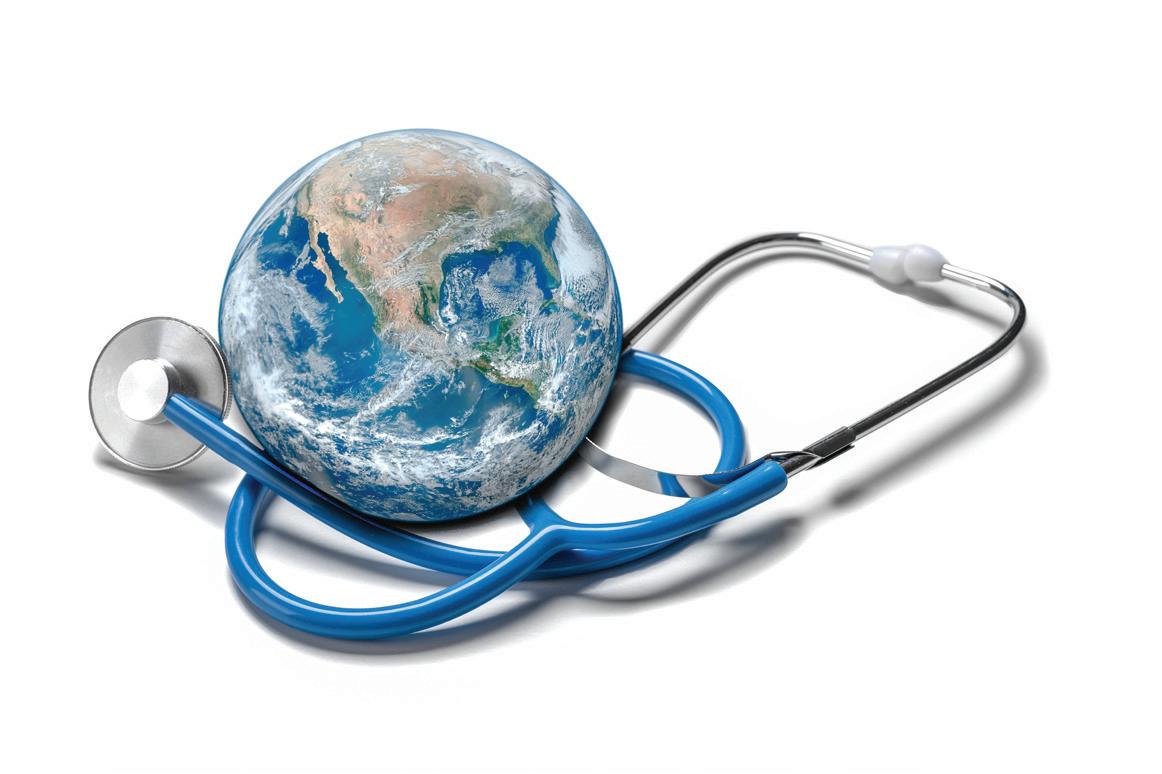HOUSTON’S FUTURE: THE INTERSECTION OF CLIMATE CHANGE AND HEALTH CARE

20 24
CENTER FOR HOUSTON’S FUTURE















HOUSTON’S FUTURE: THE INTERSECTION OF CLIMATE CHANGE AND HEALTH CARE

20 24
CENTER FOR HOUSTON’S FUTURE














Center for Houston’s Future is a nonprofit that works to understand future global trends and their impact on the Houston region. We focus on issues that are critical to the long-term success of Greater Houston. In short, we aim to ensure Houston remains a great place to live and work for all its residents. We bring business, government, community, and academic stakeholders to engage in planning, research, consensus building and action.
Jessica Abbinett, MPH, REHS, Harris County Public Health Office of Epidemiology and Surveillance
Alim D Adatia, Johnson Controls Inc
Mayar Al Mohajer, MD MPH MBA FIDSA FSHEA FAPIC FACHE, Baylor St. Luke’s Medical Center
Bettina M. Beech, DrPH, MPH, University of Houston
Jason Fischer, MBA, Houston Methodist
Jackie Fisherman, JD, St. Luke’s Health
Ruben Garcia, CHFM, St. Luke’s Health
Jaime González, The Nature Conservancy in Texas
Yun Hang, PhD, Health-Atmosphere Nexus Group at UTHealth Houston
Peter Jay Hotez, MD, PhD, Texas Children’s Hospital and Baylor College of Medicine
Jennifer Kiger, MPH, Harris County Public Health Office of Epidemiology and Surveillance
Ryan Kirane, HonorHealth Phoenix
Kevin Lanza, PhD, UTHealth School of Public Health
Pouyan Layegh, PE MBA - LEED AP, UT MD Anderson Cancer Center
Linette Leadon, UT MD Anderson Cancer Center
Sister Mary Ellen Leciejewski, CommonSpirit Health
Bradley Lembcke, MD, St. Luke’s Health
Lisa Lin, LEED AP, Director of Sustainability, Harris County
Jay Maddock, PhD, Center for Health and Nature
Daniel P. Mahoney, MD, FAAP, Texas Children’s Hospital
Lauren Manning Salomon, PhD, Harris Health System
Chris Okezie, MBA, FACHE, Harris Health System
Scott Packard, St. Luke’s Health
William Brett Perkison MD, MPH, FACOEM, UTHealth School of Public Health
Lee Rodriguez, PhD, MBA, MAM, San José Clinic
Rachel Roy, PhD, MPH, Harris County Public Health Office of Epidemiology and Surveillance
Hardeep Singh, MD MPH, Michael E. DeBakey Veterans Affairs Medical Center, and Baylor College of Medicine
Mark T. Sloan, Harris County Office of Homeland Security and Emergency Management
Cindy Yeilding, Board Chair, Center for Houston’s Future
In this report, we examine the critical intersection of climate change and health care in the Houston region. We identify the health threats posed by climate change, such as extreme heat, air quality degradation, and increased frequency of extreme weather events. Our analysis outlines necessary actions for the health care sector to address these challenges, emphasizing the importance of collaboration at multiple levels.
Houston is particularly vulnerable to climate-driven disasters, with projected increases in extreme heat, floods, and hurricanes.
These events will exacerbate existing health problems, including heatstroke, respiratory illnesses, mental health challenges, and a rise in tropical and vector-borne diseases, disproportionately impacting marginalized communities.
The U.S. health care sector, itself responsible for 8.5% of national greenhouse gas emissions, increasingly is recognizing its dual role in climate change: reducing emissions and integrating climate health into care.
BY WORKING TOGETHER, HOUSTON’S HEALTH CARE SYSTEM CAN ADAPT TO AND MITIGATE THE EFFECTS OF CLIMATE CHANGE:
⊲ Build collaborations within, between, and beyond local health care systems to share strategies and access grant funding.
⊲ Cultivate leadership commitment and physician champions to inspire and guide their peers in tackling climate change.
⊲ Educate health care professionals and students on climate health and decarbonization strategies, through formal curricula integrated into health care degree programs, including medical, nursing, and public health schools, as well as continuing education programs.
⊲ Influence procurement and hospital investments through climate-related criteria.
⊲ Advocate for policies and actions that support decarbonization and create more ecofriendly green spaces in hospitals, in low-income communities, and across the region.
⊲ Gather climate-related health data and foster open communication between health professionals and researchers to guide critical research and inform effective climate health action.
⊲ Benchmark, track, and publish GHG emissions to foster accountability and reduce environmental impacts of the health care sector.
⊲ Leverage national and multi-national organizations like Practice Greenhealth, Healthcare Without Harm, ASHE, OCCHE, and the National Academy of Medicine that provide resources, frameworks, and guidance for decarbonizing the health care sector.
This report underscores the urgent need for Houston’s health care systems to actively participate in climate change mitigation and adaptation efforts. By adopting collaborative strategies and leveraging technological innovations, health care providers can play a pivotal role in safeguarding the health of Houston’s residents against the backdrop of an evolving climate landscape.
Houston and its internationally recognized medical community face a crucial challenge: addressing the complex intersections of climate change and health care. Center for Houston’s Future (CHF) set out to understand the gaps, challenges, and opportunities surrounding this issue.
We found that some health care leaders and professionals are actively tackling current and prospective challenges posed by climate change. However, others, for assorted reasons, have yet to dedicate significant resources or engage in public discourse on this issue. This mirrors a broader trend across many industries, where valuable work often occurs in silos.
The Center, with its expertise both in energy and climate, and in health care and health equity initiated this research project with the generous support of St. Luke’s Health. This was motivated by a growing recognition of the strong connection between climate change and health care, and the pressing need for our region to act.
Health care systems are on the front lines of treating and preventing climate-induced or climate-exacerbated health issues, but they also contribute to the problem, with the U.S. health care sector accounting for 8.5% of total greenhouse gas (GHG) emissions nationally. The international medical community recognizes this dual role, with 230 medical journals signing onto and publishing an editorial declaring climate change as the “greatest threat” to health in 2021.2, 3
The need for action is even more pressing for cities like Houston, acutely vulnerable to climate-driven disasters. The Houston Climate Impact Assessment 2.0 outlines an alarming projected increase in heatwaves (by 30% by 2050), floods (with annual economic losses reaching $5 billion by 2050), and hurricanes (intensifying in severity and frequency).3,4 Compounding these threats are urban heat islands, expected to contribute to a 50% increase in heat-related deaths by midcentury.3 Building a resilient
health care system in the face of these challenges demands immediate attention.
This paper examines the leadership role Houston’s hospitals can play in navigating this complex relationship. By exploring key strategies tailored for the region’s unique characteristics and drawing insights from local experts, this report informs and guides stakeholders in building a healthier, more sustainable future for Houston and its health care system.
Our research is based on a comprehensive review of more than 60 studies, articles, and resources; interviews with more than 20 regional and subject matter experts; and a roundtable discussion with regional experts and stakeholders.
Houston faces a multitude of health threats due to climate change. Extreme heat leads to heatstroke, worsens respiratory issues like asthma, and can even trigger cardiovascular problems.6, 7 More frequent and severe floods, like Hurricane Harvey, expose residents to contaminated water, increasing the risk of waterborne diseases and mosquito-borne illnesses.7, 8 Air quality suffers from rising ozone and particulate matter, further compromising respiratory health.6 Climate change also disrupts food production and distribution, potentially leading to malnutrition, while extreme weather events like hurricanes can contaminate water sources and damage infrastructure, exacerbating existing health disparities.5, 9 The mental health toll of climate disasters, particularly on children, necessitates increased support services.9 Urgent action to mitigate climate change and address the disparate economic impact of climate change on historically underserved communities is crucial to safeguard Houston’s residents and build a healthier future for all.
As described in the chart on the right, there are many links between the impacts of climate change and the health of our community.
⊲ Air Quality Impacts: Houston is ranked as the 8th most polluted city in the United States for ozone pollution.13
⊲ Food Safety and Nutrition: Elevated CO2 levels harm crop nutritional quality.6
⊲ Mental Health Challenges: A survey found that 59% of respondents aged 16-24 expressed deep worry about climate change.16
Source: Climate Nexus
⊲ Cancer: A recent study found that patients with nonsmall cell lung cancer experienced lower survival rates due to interrupted radiation therapy following hurricanes.15
⊲ Temperature Related Death and Illness: Houston ranks fourth in the U.S. for heat island intensity, with lowincome communities experiencing up to 17 degrees higher temperatures and persistent night heat – the leading cause of heat-related illnesses.10, 11
⊲ Extreme Weather Events: Hurricane Harvey, which hit Texas in 2017, caused extensive flooding and at least 63 deaths.8 Katharine Hayhoe, a climate scientist at Texas Tech University, links climate change to Hurricane Harvey’s severity.12
⊲ Vector Borne and Tropical Infectious Diseases: Dr. Peter J. Hotez, Dean for the National School of Tropical Medicine, predicts an increase in vector-borne diseases in low-income areas of Houston in the next 20 years, highlighting the importance of proactive public health measures.
⊲ Water Related Illness: A 2023 report declared Texas has the most ‘brain-eating’ amoeba infections in the U.S. While extremely rare, warmer lake water is conducive for these amoebas.14
⊲ Health Equity and Climate Change: Historic practices like redlining contribute to disparities in green space distribution and pollution siting, impacting health outcomes.7
Extreme heat, claiming over 300,000 lives globally each year, poses a severe threat. Houston, ranking fourth in the U.S. for heat island intensity, serves as a microcosm of this crisis.11, 9 This phenomenon traps heat in places lacking green space, leading to higher temperatures and persistent night heat. These factors disproportionately impact low-income and marginalized residents, contributing to a surge in heat-related emergency calls in 2023 according to the Houston Fire Department.17, 7 The chart below shows the annual peak in heat related emergency department calls has increased significantly in recent years. Research suggests an alarming 85% increase in heat-related deaths among adults over 65 worldwide since the 1990s, with climate change playing a substantial role.18
The urgency is undeniable. Not only is extreme heat the deadliest weather hazard in the U.S., but it also exacerbates existing health conditions.9 In Houston, the spectrum of heat-related illnesses includes cardiovascular and respiratory problems, kidney issues, and negative pregnancy outcomes.6 Additionally, heat waves worsen allergies, pollen symptoms, and foodborne illness risks.7
Vulnerability is unevenly distributed, with older adults, children, the unhoused, and outdoor workers facing the greatest risk. Medications for common conditions in older adults can further hinder their ability to regulate body temperature. This complex interplay demands immediate action and heightened awareness to protect Houstonians, including our most vulnerable residents.
By actively engaging beyond the clinic walls, the health care sector can become champions for healthier communities and mitigate the scorching threat of heat in Houston.
Houston Harris Heat Action Team (H3AT):
Launched the Heat Watch campaign in 2020, mapping temperature disparities and advocating for urban heat island mitigation strategies.11
Reliant’s Beat the Heat Program & 211 Texas: Offer air conditioning assistance to eligible individuals and families.19, 20
Houston’s increasing vulnerability to floods and hurricanes poses a significant threat to public health. With a 24% rise in rainfall intensity since the early 20th century, coupled with land subsidence and rising sea levels, the city faces a perfect storm of flood risks.21, 5
Flooding events expose residents to a cascade of health dangers. Contaminated water increases the risk of waterborne diseases like cholera and hepatitis A, as seen in studies following Hurricane Harvey.8 Disrupted industrial processes release pollutants that worsen respiratory problems, while damp environments promote mold growth, triggering allergies and asthma.6 Skin infections and mosquito-borne diseases like West Nile virus further compound the health risks.7
The long-term consequences are equally concerning. Repeated exposure to contaminated water, mold, and the psychological stress of recurring disasters can lead to chronic health problems like cardiovascular disease, respiratory illness, and kidney disease.9
Climate change is a major driver of this crisis, with rising global temperatures fueling heavier rainfall and stronger storms.22 Houston’s unique situation, with land subsidence exacerbating sea level rise – second highest in North America – creates a dangerous situation where even minor floods can have devastating consequences.5
conditions.10 Houston’s subtropical climate and urban heat islands further intensify the harmful effects of air pollution, creating a critical public health concern.
The confluence of climate change, urbanization, poverty, and increased human migration are creating conditions in South Texas and Houston that could lead to a rise in vector-borne tropical infections.24 This concern is supported by the emergence of Zika virus in South Texas in 2016 and the identification of a possible dengue outbreak in Houston in the early 2000s. Experts predict that these “arbovirus” infections, transmitted by insects like mosquitoes, may become more common in Texas and the Gulf Coast, with the potential return of yellow fever. 25, 26 Other vector-borne illnesses of concern include typhus, Chagas disease, and parasitic worm infections like human hookworm.
These growing threats motivated the establishment of the National School of Tropical Medicine at Baylor College of Medicine in 2011. Additionally, Texas Children’s Hospital Center for Vaccine Development is collaborating with other institutions, including UTMB Galveston and the Galveston National Laboratory, to develop new vaccines and diagnostic tools for these neglected tropical diseases. Texas medical researchers are also advocating for new STOP Neglected Tropical Disease legislation in the U.S. Congress to address these threats.27, 29



























The Heat-Related illness chart shows daily rates for each U.S. Department of Health and Human Services (HHS) region of emergency department (ED) visits associated with heatrelated illness (HRI) per 100,000 ED visits using data available through the National Syndromatic Surveillance Program (NSSP) at the Centers for Disease Control and Prevention.
Houston’s residents face a double threat from air pollution: ground-level ozone and particulate matter (PM). Ozone, formed by sunlight and pollutants, irritates the lungs, and can lead to respiratory infections, inflammation, and even premature death. PM2.5, a specific type of particulate matter, penetrates deep into the lungs and bloodstream, increasing risks of heart disease, stroke, and lung cancer.9 Levels of PM2.5 have risen in recent years, further compounding the issue.23
Climate change adds another layer of complexity. Droughts, more common with climate change, increase airborne dust and PM, while rising temperatures accelerate ozone formation 6 These factors disproportionately impact vulnerable populations like children, older adults, and those with existing health
Climate change poses significant challenges for oncology, with extreme weather events like hurricanes and wildfires increasing cancer risks by releasing carcinogens and reducing survival rates by interrupting care. For example, during Hurricane Harvey, heavy precipitation inundating these facilities in Houston caused the release of significant amounts of carcinogens, highlighting the link between climate change and cancer risk. The process of shutting down and restarting facilities, often necessitated by extreme weather, can result in the emission of more pollution than normal operational periods.28 A Texas report revealed that industrial facilities tend to emit most of the pollution during the initial days of a storm, when monitoring is most challenging, exacerbating health risks.29
Furthermore, climate change disrupts cancer care, as seen when patients with non-small cell lung cancer experienced lower survival rates due to interrupted radiation therapy following hurricanes.15 These examples underscore the urgent need for health care systems to adapt and ensure continuous care amidst the increasing frequency of extreme weather events, while also addressing the heightened pollution from industrial responses to these events.
The mental health toll of climate-related disasters, such as floods and hurricanes, is increasingly evident and particularly profound in children. A meta-analysis published in the journal Environmental Health Perspectives revealed that 30% of children develop significant post traumatic stress symptoms following such events, highlighting the need for long-term support and intervention.32
Moreover, a global survey published in The Lancet paints a concerning picture of the pervasive anxiety and fear among young people regarding climate change. The survey found that 59% of respondents aged 16-24 expressed deep worry about climate change, and over 45% reported daily impacts on their mental health 33 This anxiety affects various aspects of life, including sleep, relationships, and overall wellbeing.
Additionally, there is a troubling link between rising temperatures and mental health issues. A study published in Environmental Health Perspectives found an alarming increase in emergency department visits for mental illness, suicides, and poor mental health days correlating with higher temperatures.34 This suggests a distinct psychological and behavioral vulnerability to climate warming, with sleep disruption likely playing a significant role in emotional regulation and wellbeing.34
Houston faces a critical challenge as climate change intersects with longstanding inequities in health outcomes. Vulnerable populations, already burdened by historical injustices, experience a disproportionate share of environmental hazards.
Vulnerability to climate-related health risks is determined by sensitivity to these risks, exposure levels, and response capacity. Individuals with preexisting health conditions, outdoor occupations, and limited health care access are more susceptible to extreme weather and air pollution compared to healthier individuals with greater resources. Vulnerable populations encompass low-income communities, communities of color, immigrant groups, children, pregnant women, older adults, and individuals with disabilities.30
Past discriminatory policies like redlining have resulted in uneven distribution of resources and infrastructure. Certain neighborhoods, often populated by communities of color, low-income families, and immigrant groups, have less green space, more asphalt, and higher exposure to industrial facilities and highways. This legacy translates to increased vulnerability to climate induced disasters and heightened social and health risks.31
Communities near industrial zones (fence-line communities) face disproportionate exposure to air and water pollutants, primarily affecting marginalized and low-income families. These communities bear the brunt of health hazards from nearby industrial facilities, experiencing higher rates of respiratory issues, cardiovascular diseases, and cancer.31















Climate change poses a significant threat to the financial stability of the U.S. health care system. According to the National Resources Defense Council (NRDC), air pollution and climate change already cost over $800 billion annually.35,36 Specific climate related illnesses, like West Nile virus, are projected to cost an additional $1.1 billion by 2050.36
Globally, the World Economic Forum projects an additional $1.1 trillion burden on the system by 2050 due to climate change.35
Beyond direct health care costs, climate change also disrupts health care operations, leading to increased expenses. Damaged infrastructure, like that experienced in Puerto Rico after Hurricane Maria that caused critical IV bag shortages, demonstrated the vulnerability of supply chains.37 Similarly, the 2021 Texas winter storm overwhelmed hospitals and forced the cancellation of elective surgeries, resulting in an estimated $4.3 billion cost.37
A broader study analyzing diverse climate events in 2012 across the U.S. revealed a staggering $10 billion in health-related costs, encompassing hospital admissions, emergency department visits, and lost wages.38 These diverse events, including wildfires, extreme heat, and infectious disease outbreaks, highlight the widespread health impacts of climate change.
Mitigating climate change and adapting health care systems are essential to ensure continued accessibility and stability in the face of these growing challenges.



The non-financial costs pose an equally compelling challenge for Houston’s health care system. The recurring experience of intense storms, like Hurricane Harvey, has taken an emotional toll on health care professionals in Houston, leading to symptoms of sleep disruption, anxiety, and emotional dysregulation.



The stress from repeated exposure to climate related disasters can significantly contribute to burnout among health care professionals, as they face the demanding task of caring for communities during and after these events. Studies have shown that climate change can exacerbate staff burnout, creating a vicious cycle that threatens health care system capacity.39 This can ultimately lead to reduced quality of care and decreased staff retention, jeopardizing the overall effectiveness of the health care system.
The growing frequency and complexity of climate related health issues necessitate a larger and climate ready health care workforce. This requires training to address specific climate related risks, such as identifying and managing climate-sensitive illnesses. Additionally, adaptation strategies to deliver care under challenging circumstances, like limited resources or power outages, are crucial for ensuring continuity of care.
A Local Model of Integrating Climate Health into Care: San Jose Clinic’s Heat Alert Program
Dr. Lee Rodriguez, practice, and quality director at San Jose Clinic, has noted significant improvements in health metrics and patient follow-up care rates since the piloting a Climate Resilience for Frontline Clinics toolkit codeveloped by AMERICARES, Harvard T. H. Chan, and C-CHANGE. Dr. Rodriguez attributes some of the positive outcomes to improved dialogue between physicians and patients, which has shed light on factors affecting patients’ health, such as no air conditioning or exposure to outdoor conditions.
The San Jose Clinic is one of 17 clinics and emergency departments piloting the Climate Resilience for Frontline Clinics toolkit, which has four tracks (heat, flood, wildfire, hurricane). San Jose Clinic was selected to pilot the Heat Alert program. The program involves identifying patients who are particularly vulnerable to extreme heat, educating patients on heat issues specific to their needs, and sending them alerts and advisories before and during heat events. Proactive communication ensures patients are well informed and can take precautions to protect their health.
The integration of climate health into patient care, coupled with direct communication and proactive measures like the Heat Alert program, is key for providers to effectively address the health impacts of climate change. Results from San Jose Clinic underscore the value of such strategies in improving patient health outcomes and fostering community resilience.
As Houstonians, we face a critical challenge: adapting our health care system to a changing climate while safeguarding our community’s health. This report offers ideas to empower local health care institutions and other stakeholders to act individually and through collaborative action. We explore a comprehensive approach to address climate change’s impact on health and reduce the sector’s environmental footprint, specifically tailored to the needs and vulnerabilities of our community.
This approach calls for strong collaboration in and between our health care organizations. By sharing best practices, pooling resources, and formulating a unified approach, Houston’s health care system can tackle the challenges of climate change. From adopting sustainable technologies and enhancing facility resilience to fostering education and advocacy among health care professionals, this roadmap equips our health care system to navigate the complexities of climate health. By ensuring both a sustainable health care delivery system and the well-being of our families, these collaborative solutions will protect public health in Houston for generations to come.
Climate change isn’t just about carbon footprints. It’s a health care crisis already impacting our communities. As frontline responders, health care systems and providers are uniquely positioned to address the evolving health threats arising from climate change. This section of the report focuses on how to integrate climate health into the fabric of health care delivery, encompassing patient education, treatment plans, and facility resilience to ensure our community’s well-being. In the next section, we’ll explore strategies for health care systems to minimize their own environmental impact.
Climate change demands a comprehensive approach to patient care, one that addresses immediate and long-term health impacts. This means treating the immediate effects of extreme weather events and building patient resilience by tackling underlying health issues, chronic diseases, social determinants of health (SDoH), and ensuring proper vaccinations.40
Identifying Vulnerable Patients: Incorporating climate health questions into patient intake forms is a crucial first step to providers identifying patients at increased risk due to specific health issues (e.g., asthma, cardiovascular disease), environmental conditions (e.g., poor air quality), or life circumstances (e.g., lack of air conditioning, outdoor work, living in flood prone areas).41
Protocols for Climate-Sensitive Care: Developing protocols for climate-sensitive diseases ensures effective integration of environmental factors into care delivery. This includes considering how air quality and temperature may affect chronic conditions like asthma or cardiovascular diseases.
Personalized Patient Care Plans: Based on intake information, providers can develop personalized care plans to address each patient’s unique vulnerabilities to climate related health issues.
Mental Health Integration: Acknowledge climate-driven mental health challenges and integrate this understanding into patient care.
Focus on Rural Areas: Recognizing that rural areas have less access to health care and SDoH services, targeted efforts are needed to bridge these gaps.41
To enable health professionals to incorporate climate health into care delivery, it is essential they are reimbursed for climate consultations. This requires support from health system administrators and may involve advocating for policy changes to recognize the importance of climate health in patient care.
Telehealth Expansion: Minimize exposure to extreme weather for patients and health care workers and decrease transportation-related greenhouse gas emissions.
Alerts and Advisories: Implementing a system to provide patients with alerts and advisories about extreme weather events and infectious disease outbreaks can help them take precautions.
Electronic Health Records (EHR) Integration: Connecting EHRs with community service resources facilitates seamless coordination between health care providers and social services.
Remote Monitoring: Wearable technology and smart sensors can facilitate early detection of climate-induced illnesses and offer personalized advice based on environmental conditions.
AI and Analytics: Leveraging environmental data can help providers understand the climate footprint of stakeholders and identify health trends associated with rising temperatures.
By adopting these strategies and leveraging technological innovations, providers can significantly enhance their ability to adapt patient care for climate health.
To effectively engage health care professionals in climate health, a long-term, strategic approach is essential. This involves securing the commitment of health care leaders and nurturing physician champions in senior roles to drive the initiative and ensure integration throughout an organization. Support for these champions is critical, including providing hospital resources, public recognition, and opportunities for them to share their progress with senior leadership, thereby cultivating an organizational culture of engagement.
Proactively addressing potential concerns from physicians, such as the impact on their time or autonomy, is key to minimizing resistance and fostering collaboration. Establishing a strong communication framework that encourages open dialogue in settings like grand rounds, and offering compensation for climate-related consultations, are fundamental. A wellcrafted communication plan is also necessary to deliver clear messages, reach the appropriate audience, and incorporate feedback mechanisms.
Sister Mary Ellen Leciejewski, system vice president for environmental sustainability at CommonSpirit Health, which is the parent company of St. Luke’s Health, suggests initiating the process with a survey of Houston physicians to gauge their awareness, attitudes, and willingness to participate in climate health initiatives. This is crucial for mapping the current situation and pinpointing educational and resource gaps.
The adoption of climate health into medical and nursing education nationwide is advancing. A survey by the Association of American Medical Colleges (AAMC) for the academic year 2021-2022 indicated that 55% of U.S. medical schools now cover the health effects of climate change, up from 27% in the 2019-2020 academic year. Nursing schools are also incorporating climate change into their curricula.
Collaborative initiatives like the Nurses Climate Challenge (NCC), created by the Alliance of Nurses for Healthy Environments (ANHE) and Health Care Without Harm (HCWH), are mobilizing nurses to educate health
79% of clinicians say their hospitals should be involved in climate change
40% of clinicians say that climate change is aligned with their organization’s mission
80% of clinicians believe their hospitals should be working on climate change and its effects
33% of clinicians believe it’s important for them to reduce their environmental impact at work and at home
Many clinicians say that a prospective employer’s policies and actions on climate change will impact their decision to apply for a job.
professionals on climate change’s health impacts. The Climate Resources for Health Education (CRHE), a global student-led initiative housed at the Global Consortium on Climate and Health Education (GCCHE), provides free, evidence-based resources to accelerate the incorporation of climate change and planetary health information into educational curricula, further supporting the integration of climate health into health care training. Several more resources for climate health education are available in the Appendix.
Including climate health education in health care curricula is crucial for creating a knowledgeable and proactive health care workforce that can advocate for sustainable practices, support protective policies, and effectively prevent and treat climate-related health issues. More sources and organizations are included in the Appendix.
Health care professionals play a crucial role in advocating for climate health due to their trusted position as experts and firsthand experience witnessing the impacts of climate change. They can champion policies that promote environmental justice, clean air, food and water security, access to health care, and support for research into vector-borne diseases. Their advocacy extends beyond health care settings, influencing government policies and emphasizing the
urgent need for a coordinated response to climate-related health threats, both physical and mental. Health workers can leverage various advocacy channels, including professional organizations, public communication campaigns, and direct outreach to decision-makers. For those seeking advocacy training and resources, a list from reputable organizations can be found in the Appendix.
Climate change poses a significant threat to public health. Fortunately, local public health professionals have begun implementing strategies such as education, awareness, and data driven interventions.
Nationally recognized frameworks like the CDC’s Climate Ready States and Cities Initiative (CRSCI) and Building Resilience Against Climate Effects (BRACE) framework equip health departments with tools and guidance for proactive planning and response to climate change’s health impacts.7 Programs like the low-income Home Energy Assistance Program (LIHEAP), administered by the Department of Health and Human Services, can help eligible households afford cooling assistance during summer months, mitigating heat-related illnesses.42 Community health needs assessments, conducted by local health departments, play a crucial role in identifying and addressing specific climate related vulnerabilities faced by diverse populations within the community.
This list of recommended strategies outlines the roles and actions of public health departments, local governments, health care systems, providers, and the broader community in creating a sustainable and health-focused response to the climate crisis.
Surveillance and Early Warning: Implement real-time monitoring of heat index and air quality, issuing alerts to health care providers and vulnerable populations.
Community Outreach: Educate residents on heat stress symptoms, prevention measures, and how to access cooling centers.
Heat Safe Spaces: Establish cooling centers in hospitals and communities, equipped with water, ventilation, and medical supplies.
Urban Design: Increase greenery, use reflective building materials, and promote sustainable urban design to mitigate heat islands and enhance green spaces, especially in underserved areas.
Public Education: Implement public education campaigns on the health impacts of climate change and early warning systems for heat and extreme weather.
Disaster Preparedness: Develop plans that consider the specific needs of vulnerable groups to ensure adequate support during climate emergencies.
Heat Safety Awareness
Campaigns: The City of Houston offers residents information on staying cool and recognizing heat related illnesses.
The Nature Conservancy of Texas’ Prairie Projects: This initiative focuses on restoring native prairies, which can naturally cool the environment and promote biodiversity, providing a nature-based solution to climate challenges.
H3AT’s Heat Mapping Project: This project identified Houston’s hottest areas, allowing for targeted cooling efforts, such as the creation of green spaces and directing resources to vulnerable communities. Harris County Public Health’s Environmental Public Health Division: This division actively monitors and mitigates the public health impacts of climate change, safeguarding the wellbeing of Houston’s residents.
By adopting these strategies and empowering local efforts, Houston showcases its commitment to building resilience against climate change and its health impacts, serving as a model for other communities.
The intersection of data collection, research, and clinical practice is pivotal for understanding and addressing the health impacts of climate change. Collaboration between physicians and researchers is essential for developing effective strategies to protect public health in the face of climate change.
Physicians are on the frontlines, observing direct and indirect health effects of climate change on patients, including heat-related illnesses and the exacerbation of chronic diseases. Researchers, in turn, rely on insights from physicians to tailor studies to meet clinical needs and inform physicians. This two-way communication is crucial to ensure research is relevant and that clinical practices are informed by the latest evidence.
Data collection through patient intake forms is vital for identifying vulnerable populations, such as those with chronic diseases or lifestyle risk factors. The use of standardized ICD codes and the inclusion of climate health language in Electronic Health Records (EHR) fields can potentially enhance the tracking and understanding of climate related illnesses. Currently, Harris County Public Health is conducting disease-burden modeling to predict future health impacts under different climate scenarios.
NASA’s satellite data can be applied to accurately estimate air quality levels across different regions, including Houston. Yun Hang, the primary investigator for the Health-Atmosphere Nexus Group at UTHealth Houston, participated in a CHF roundtable on climate change and health care and shared that “this technology enables public health officials to identify areas with poor air quality that may pose health risks to residents and extend that research to low-income areas where ground monitoring is sparse.” Furthermore, NASA offers funding for using NASA Earth Observations to support studies that explore the relationship between air quality, climate change, and health outcomes.
Technological innovations, such as virtual care and remote monitoring, reduce greenhouse gas emissions by minimizing patient travel. These advancements also facilitate the early detection and management of climateinduced illnesses. Artificial Intelligence (AI) and machine learning further enhance personalized patient care by analyzing environmental conditions.43 Moreover, intelligent search and analytics tools rapidly identify health trends influenced by climate change, supporting both research and clinical practice.44
By leveraging data collection, research, and technological innovations, health care professionals in Houston can enhance their understanding and management of climate health issues.
Houston’s vulnerability to hurricanes, floods, and other climate disasters has made the city a leader in health care resilience. Local hospitals and the Harris County Office of Homeland Security and Emergency Management (HCOHSEM) have implemented a multifaceted approach to ensure continued quality care during disruptions, serving as a model for other cities facing similar challenges.
These strategies emphasize comprehensive emergency preparedness through detailed evacuation procedures, patient care relocation strategies, and efficient resource mobilization. Advanced testing platforms like CenTrack can simulate disaster scenarios, pinpointing vulnerabilities, and refining response strategies.
Rigorous risk assessment, informed by local experts like HCOHSEM, is crucial. This involves a thorough analysis of the health care system’s operations, supply chains, and the community’s health needs to address both current and future climate risks effectively.
Prepared personnel are also vital, with protocols established for critical staff to remain onsite during emergencies, ensuring the continuity of essential health care services.
Operational redundancy safeguards against disruptions. Investing in backup generators powered by low-carbon fuels like natural gas or hydrogen and incorporating floodresistant infrastructure like elevated facilities and barriers, mitigates power outages and water damage risks.
Building resilient supply chains involves collaborating with suppliers to diversify and stockpile essential medical supplies, guaranteeing uninterrupted access during disruptions.
Recognizing climate change as a threat to health care access, quality, and financial viability is crucial, and proactive measures to address these potential impacts are essential. By implementing these recommendations and leveraging local expertise, Houston’s health care system can significantly enhance its resilience, ensuring continued access to quality health care for the community in the face of climate change challenges.
The health care sector, while dedicated to healing and promoting health, paradoxically contributes to climate health issues through its own greenhouse gas (GHG) emissions. The health care sector’s environmental footprint is notable, with the United States health care system accounting for 8.5% of U.S. emissions, impacting public health by an estimated 405,000 disability-adjusted life years annually. If it were a country, the global health care sector would be the world’s fifth largest carbon emitter.45, 46
Given its size and medical infrastructure, it is important that Houston does its part to decarbonize health care.
GHG emissions in health care are categorized into three scopes according to the Greenhouse Gas Protocol, which helps organizations manage and reduce carbon footprints.
Scope 1 and 2 emissions encompass direct and indirect emissions from energy consumption for lighting, heating, cooling, and operating medical equipment, often derived from fossil fuels. Onsite transportation, such as patient transport and medical supply delivery, also contributes to these emissions.
Scope 3 emissions, which account for over 70% of health care emissions, include emissions from the entire lifecycle of medical equipment, pharmaceuticals, anesthesia gases (which can be thousands of times more potent than carbon dioxide), transportation, waste generation and management, and building construction and maintenance.45
Efforts to mitigate GHG emissions in health care focus on enhancing energy efficiency, transitioning to renewable energy or lower-carbon sources, adopting sustainable procurement and waste management practices, and promoting environmentally conscious behavior among health care professionals and patients. Additionally, initiatives are underway to develop and use more sustainable medical technologies.
Freight transport
Pioneering Decarbonization at CommonSpirit Health
Sister Mary Ellen Leciejewski, a Dominican Sister and system vice president for environmental sustainability at CommonSpirit Health, has played a pivotal role in championing health care sustainability for almost three decades.
Her journey began in the mid 1990’s with a focus on recycling at Dignity Health Dominican Santa Cruz. Alongside her recycling colleagues, affectionately known as the “trash talking nuns,” she laid the groundwork for a comprehensive sustainability program. Throughout the years, Sister Mary Ellen has been a driving force in expanding CommonSpirit Health’s sustainability efforts, encompassing waste management, food sourcing, chemical usage, green building practices, climate action, health equity and the formation of hospital green teams.
In 2013, CHI acquired Houston’s St. Luke’s Health, and the subsequent merger of Dignity Health and CHI in 2019 formed CommonSpirit Health, a nonprofit health system with 142 hospitals and more than 2,250 care sites across 24 states and 150,000 employees. Sister Mary Ellen leads systemwide sustainability initiatives.
Under her guidance, CommonSpirit Health has committed to achieving net zero emissions by 2040 and reducing emissions by 50% by 2030. This ambitious climate action plan is based on three pillars: addressing direct emissions from energy use and operations, focusing on indirect emissions from purchased goods and services, and meeting the health needs of vulnerable communities impacted by climate change.
Notable achievements include divesting from coal investments in 2015, participating in the inaugural Healthcare Climate Council, advocating for the Inflation Reduction Act, and implementing food waste programs in California hospitals. Ongoing efforts involve eliminating harmful chemicals and substituting single-use plastics with sustainable alternatives.
Sister Mary Ellen’s story exemplifies how health care systems can integrate sustainability into their operations, procurement, and advocacy endeavors. Through partnerships with leading vendors and a focus on supply chain emissions, CommonSpirit Health is providing a framework for others to follow.
As a contributor to global greenhouse gas (GHG) emissions, the health care industry is increasingly recognizing the urgent need to reduce its carbon footprint and transition to more sustainable practices. This shift aligns with global efforts to mitigate the root causes of climate change and enhances the sector’s resilience and capacity to adapt to a changing climate. Moreover, it presents an opportunity for health care organizations to lead by example, pioneering innovative products, services, and care models that promote health and wellness while minimizing environmental impact.
Adopting climate resiliency as an organization-wide strategy involves aligning stakeholders on strategic priorities for addressing climate change. Creating a dedicated C-suite role focused on climate resiliency can drive the sustainability agenda, addressing both the
causes and impacts of climate change, and overseeing the broader environmental, social, and governance (ESG) portfolio.
The foundation for a successful decarbonization effort lies in accurate benchmarking and tracking of current climate health impacts, challenges, and vulnerabilities. The health care delivery sector has historically lagged other sectors in sustainability reporting. By publicly reporting sustainability activities, organizations can create accountability for quantifying and reducing environmental impacts, which can lead to lower costs and improved health.
Signing carbon reduction pledges is another key mechanism for promoting decarbonization. The Health Sector Climate Pledge, launched by the U.S. Department of Health and Human Services (HHS), is a voluntary
commitment to climate resilience and emissions reduction. It includes ambitious targets such as cutting GHG emissions by 50 percent by 2030 and achieving net zero emissions by 2050.47 In Houston, notable signatories include St. Luke’s Health, Texas Children’s Hospital, and the Michael E. DeBakey VA Medical Center.
Several national organizations are leading the development of roadmaps and guidance for decarbonizing the health care sector, including Practice Greenhealth, Healthcare Without Harm, the American Society for Health Care Engineering (ASHE), and the National Academy of Medicine (NAM), which provide essential resources and frameworks to support health care organizations.
For instance, Practice Greenhealth provides tools for GHG emissions accounting, while Healthcare Without Harm advocates for strategies that align health care with environmental health. ASHE focuses on optimizing the physical health care environment, and NAM’s Action Collaborative on Decarbonizing the U.S. Health Sector serves as a platform for sharing best practices and advancing policy recommendations.
The decarbonization of the health care industry requires a concerted effort across various domains, emphasizing the importance of strategic alignment, accountability, and collaboration among health care organizations and stakeholders.
Use of sold products: 0.04%
Upstream transportation & distribution: 0.37%
Business travel: 0.41%
Waste generated: 0.56%
Downstream transportation & distribution: 2%
Fuel and energy-related services: 3%
Employee commuting: 4%

Capital goods: 5%
Direct emissions: 5%
Purchased Electricty: 12%

Greenhouse gas (GHG) emissions from sources that are owned of controlled by the reporting entity. Health care examples include stationary combustion, waste anesthesia gases, refrigerants, and mobile fleet vehicles.
■ Scope 1 Includes all direct GHG emissions
Source: Practice Green Health, Data Source: ENGIE Impact analysis



Purchased goods & services: 41%












GHG emissions sources of a representative nonprofit U.S. health care system (2019 data)





Investments: 28%
GHG emissions that are a consequence of the activities of the reporting entitiy, but occur at sources owned or controlled by another entitiy.
■ Scope 2 Includes indirect GHG emissions from consumption of purchased or acquired electricity, steam, heat and cooling.
Scope 3 Includes all other indirect emissions, such as the extraction and production of purchased materials and fuels, transport-related activities in vehicles not owned or controlled by the reporting entity, electricity-related activities (e.g. T&D losses) not covered in Scope 2, outsourced activities, waste disposal, etc.
Energy Efficiency in Health Care Facilities: Energy efficiency is a critical component of decarbonization strategies in health care. Institutions in the Texas Medical Center (TMC) are implementing measures such as retrofitting outdated heating and cooling systems, transitioning to LED lighting, and promoting water conservation. These initiatives not only reduce greenhouse gas emissions but also offer substantial cost savings. The Memorial Hermann Health System, for instance, was recognized with the 2023 EPA Energy Star Partner of the Year award for its efforts in certifying 21 buildings, including 10 hospitals, in 2022.48
Optimizing Energy Use in Operating Rooms and ICUs: Operating rooms and intensive care units are among the most energy-intensive areas in hospitals. Houston hospitals, including St. Luke’s Health, MD Anderson Cancer Center, and Houston Methodist, are exploring innovative strategies to mitigate their environmental impact. These strategies include “lights-out” protocols during off-peak hours in ORs. Additionally, Houston Methodist’s “Green ICU” program introduces circadian lighting systems that emulate natural light patterns, potentially reducing energy use while enhancing patient recovery and staff wellbeing.
Renewable Energy Sources in Health Care Facilities: The transition to low-carbon energy sources is challenging for Houston’s nonprofit health care systems due to factors including upfront costs and the limited ability to use federal tax incentives. Despite such obstacles, progress is being made. The Michael E. DeBakey VA Medical Center installed elevated solar panels over carport-style covered parking, facilitated by federal funding. Houston Methodist Hospital is also advancing renewable energy integration with the design of a solar panel installation for the Josie Roberts Administration Building in the Texas Medical Center. The Inflation Reduction Act provides new funding opportunities for renewable energy projects, which could benefit nonprofit health care systems in Houston.49
Greenhouse Gas Emissions from Anesthesia: Anesthetic gases, particularly desflurane, contribute significantly to health care’s carbon footprint. Desflurane has a global warming potential (GWP) 2,500 times higher than carbon dioxide and remains in the atmosphere for 14 years, making it a potent greenhouse gas (GHG).50
Reducing emissions related to anesthetic gases is one of the low hanging fruits to start decarbonizing health care.
Dr. Hardeep Singh of the Michael E. DeBakey Veterans Affairs Medical Center, and Baylor College of Medicine
Shifting to alternatives like sevoflurane, which has a GWP 20 times lower, could significantly reduce an average U.S. hospital’s emission—equivalent to removing 1,000 cars from the road annually. Desflurane was previously touted for faster patient recovery, but recent studies find no substantial clinical evidence supporting this advantage, and it is significantly more expensive than alternatives like sevoflurane.51
The American Society of Anesthesiologists promotes a 50% reduction in anesthetic gas emissions, urging health care systems to adopt several strategies: replacing potent gases like desflurane and nitrous oxide with alternatives like sevoflurane, using low-flow anesthesia techniques that use less gas, when appropriate, using techniques like total intravenous anesthesia (TIVA) and regional anesthesia, which avoid inhaled gases, and investigating technologies for capturing and destroying waste anesthetic gas.52
A University of Wisconsin initiative exemplifies the impact of these strategies. Labeling vaporizers with environmental information led to a remarkable 55% reduction in desflurane use and $25,000 monthly savings in 2015. They subsequently removed desflurane from their formulary in 2020. This demonstrates the effectiveness of informed decision making and strategic changes in reducing the environmental impact of anesthetic gases.50
The diverse strategies for reducing Scope 1 and 2 emissions in health care, ranging from energy efficiency improvements to innovative anesthesia practices, underscore the significant opportunities for Houston’s health care systems. By leveraging each other’s experiences and collaborating, these institutions can amplify their impact, driving further decarbonization and sustainability efforts in the region.
Recycling, Composting, and Food Waste Management: Health care facilities are enhancing their sustainability efforts by initiating recycling programs for paper and




medical waste. A significant addition to these efforts is food waste composting, which can reduce waste volume and greenhouse gas emissions. Houston Methodist The Woodlands has been at the forefront of this movement, establishing a hospital-based composting program. In collaboration with Moonshot Composting and Aramark, the program has been extended to its Sugar Land and Willowbrook hospitals. As of February 2024, the initiative diverted over 171,423 pounds of food waste from landfills, which is comparable to planting 7,629 trees or reducing vehicle emissions by 114,851 miles.53











Reduction of Single-Use Plastics, PVC, and DEHP: CommonSpirit Health has made significant strides in reducing the use of single-use plastics, PVC, and DEHP. By eliminating 10 tons of single-use plastic through strategies like replacing traditional needle counters with plant-based alternatives, the organization has demonstrated a strong commitment to environmental sustainability. The “Small Change, Big Impact” program measures and reports the plastic and carbon impacts of product choices, promoting climate-smart purchasing decisions within the health care sector.54
Procurement and Supply Chain Management: One of the most impactful ways hospitals can reduce their carbon footprint is through strategic procurement and supply chain management.


⊲ Evaluating Sustainability: Hospitals assess vendors based on their commitment to energy efficiency, lowcarbon practices, and environmentally friendly products and services. Tools like the Carbon Disclosure Project (CDP) review vendor manufacturing and production processes, as well as transportation logistics. Vendors are encouraged to sign a decarbonization pledge. Vizient, a health care performance improvement company, offers a dashboard of environmentally preferred products, indicating the percentage of environmentally preferred characteristics met by each product, along with a comparison and cost differential of other products.



Supply Chain Transparency: Efforts have been launched to improve supply chain transparency and move towards all-scope emissions reductions. The Pharmaceutical Supply Chain Initiative (PSCI) is a coalition of over 45 pharmaceutical and health care companies committed to maintaining transparency and integrity in their supply chain practices through a shared audit program. Additionally, Energize is a collaboration between 10 global pharmaceutical companies aimed at increasing renewable energy access for hundreds of pharmaceutical suppliers.






⊲ Negotiating for Impact: Contracts are negotiated to include sustainability clauses and emissions reduction targets, driving positive change throughout the supply chain.
⊲ Collaborative Innovation: Partnerships with vendors foster initiatives like waste reduction, circular economy practices, and renewable energy adoption in logistics and operations.


Circular economy principles, such as remanufacturing to extend the lifespan of medical devices and lifecycle assessments to evaluate the environmental impact of products from acquisition to disposal, are being adopted. The Global Road Map for Health Care Decarbonization provides a framework for achieving zero emissions, emphasizing energy decarbonization, efficiency measures, and impactful supply chain interventions.45


Applying ESG strategies to investments: According to an analysis by ENGIE Impact, health care investment portfolios represent the second largest contributor to the sector’s environmental footprint. A new study estimates that the average hospital’s investments result in a carbon footprint equivalent to that of 1,200 homes. To reduce this footprint, hospitals can apply ESG principles to investment strategies and use their influence as major investors to encourage sustainable practices across their investment portfolios.55


Virtual and Digital Care Delivery: Increasing access to virtual appointments and remote monitoring can significantly reduce the need for patient and staff travel, thereby lowering GHG emissions associated with transportation.



By going beyond facility walls and tackling Scope 3 emissions, the healthcare sector can significantly reduce its environmental impact. Initiatives like sustainable procurement, waste management, and virtual care delivery offer a comprehensive approach to a more sustainable healthcare system. This multi-pronged strategy, alongside efforts to improve energy efficiency and integrate renewables (Scope 1 & 2), demonstrates the healthcare sector’s commitment to a healthier planet and a healthier future.



HOUSTON METHODIST established an Office of Sustainability to lead the charge in reducing the organization’s carbon footprint and promoting sustainable practices. Initiatives include installing solar panels, food waste composting, and the creation of a rooftop garden to provide a natural healing environment for visitors, staff, and patients. The hospital is also committed to sustainable infrastructure, waste management, and recycling, and actively conducts research to measure and report the environmental impact of its operations, aiming for continuous improvement in its sustainability efforts.
THE MICHAEL E. DEBAKEY VA MEDICAL CENTER is tackling climate change through a multi-pronged approach, including energy efficiency improvements, waste reduction, and solar panel installation. Several national efforts in the VA are now underway because the VA aligns with federal decarbonization goals of 50% emissions reduction by 2030 and net zero by 2050. While challenges like lack of universal reporting mandates persist for most of U.S. health care, the VA initiatives demonstrate leadership in environmental stewardship and pave the way for a more sustainable future within the health care sector.
TEXAS CHILDREN’S HOSPITAL has demonstrated a commitment to sustainability by signing onto the HHS Health Sector Climate Pledge. The hospital is also actively involved in environmental research, as evidenced by Dr. Kjersti Aagaard and Dr. Bhagavatula Moorthy receiving a National Institute of Environmental Health grant to study the impact of environmental chemicals on preterm births. This research is part of Texas Children’s Hospital’s broader efforts to understand and mitigate the effects of environmental factors on children’s health.
ST. LUKE’S HEALTH, part of CommonSpirit Health, is actively engaged in sustainability efforts to address climate change and reduce its environmental impact. The health system has committed to significant energy use reductions, aiming for a 4 percent cut in 2024, followed by a 3 percent reduction in each of the subsequent three years. These efforts are part of a broader strategy that includes signing onto multiple pledges, such as the HHS Health Sector Climate Pledge, to minimize its carbon footprint. St. Luke’s is also focusing on energy efficiency as it plans new buildings, like the new tower at the McNair campus, and retrofitting older infrastructure to implement energy-saving tactics. Its initiatives are aligned with operational efficiency goals, particularly in response to the financial strains caused by COVID-19 and include measures like reducing energy use during off-peak times. Additionally, St. Luke’s is preparing for climate driven health events by learning from past experiences with tropical storms, hurricanes, and cyberattacks, implementing safety measures, and conducting regional disaster testing with the help of CenTrak’s health care technology solutions.
THE UNIVERSITY OF TEXAS MD ANDERSON CANCER CENTER has been involved in sustainability for over two decades, with Linette Leadon and Pouyan Layegh spearheading various initiatives. Leadon, focusing on recycling and waste management, chairs the institutional sustainability advisory committee, which brings together leaders from multiple departments to foster new sustainability ideas. Layegh oversees energy and utilities, with MD Anderson having already met the UT system’s 2030 energy conservation goals and working towards NetZero. The institution uses the White House pledge as a guideline and has implemented energy efficiency strategies, such as LED lighting and HVAC optimization, to manage growth while minimizing GHG emissions. MD Anderson is also a lead writer for the ASHE’s formalized decarbonization plan, looking at sustainability from both supply and demand sides.
Championing Sustainability in Health Care: The Role of Leadership and Innovation at Houston Methodist
At Houston Methodist, a strong commitment to environmental responsibility led by CEO Marc Boom has been the driving force behind the hospital’s sustainability initiatives. In early 2023, this commitment was further solidified with the establishment of the Office of Sustainability. Boom, supported by Houston Methodist Research Institute CEO Ed Jones, recognized the need for a system-wide approach to sustainability, which was inspired by the successful “quiet sustainability” programs at the Houston Methodist Woodlands campus.
To lead this new office, they recruited Jason Fischer, whose work at the Woodlands campus had already made significant strides in sustainability. Fischer began by addressing recycling challenges, identifying service gaps, and initiating innovative solutions such
The industry faces a critical challenge in addressing multifaceted impacts of climate change. While the environmental consequences are undeniable, health care systems are increasingly recognizing the compelling financial, workforce, and ethical incentives to prioritize decarbonization and climate action. This discussion explores these diverse motivations, highlighting the potential benefits for both the health care system and the communities it serves.56
Health care systems in the United States, including those in Houston, have compelling financial reasons to embrace decarbonization and address climate health issues. These incentives offer both immediate and longterm benefits, aligning with broader environmental and public health goals.
Immediate Cost Savings: Decarbonization measures such as energy-efficient buildings, renewable energy sources, and sustainable practices can significantly
as composting food waste with Moonshot Composting. When faced with a lack of reliable plastic recycling options, he developed a comprehensive sustainability plan that encompassed energy efficiency, water conservation, and plastic waste reduction.
With the Office of Sustainability in place, Fischer has been able to scale his successful strategies across the entire Houston Methodist system. His efforts include implementing proven sustainability practices and exploring regional solutions, such as dockside autoclaving. As he looks to the future, Fischer aims to foster collaboration with other hospitals to attract more sustainability partners and contribute to a thriving circular economy in Houston.
reduce operational costs. For example, initiatives like single-use device reprocessing have saved millions of dollars for hospitals like HealthPartners.57
Boost from the Inflation Reduction Act (IRA): The IRA provides substantial financial support for clean energy investments in health care. Tax-exempt entities can benefit from direct payments for specific tax credits, effectively lowering the cost of adopting clean technologies. The IRA also extends and modifies existing credits, such as the 30% tax credit for solar and other renewable energy projects, significantly reducing the return-on-investment timeline.58, 59, 60
Mitigating Disaster Costs: Climate change fuels extreme weather events, leading to costly infrastructure damage for hospitals. While specific FEMA estimates are not retrievable, investing in resilient and sustainable infrastructure can help mitigate these potential financial burdens.
Enhanced Funding Opportunities: Robust performance on environmental, social, and governance (ESG) metrics attracts favorable terms from investors, lenders, and insurers increasingly prioritizing sustainability. This trend, driven by a growing focus on climate action, can broaden the pool of potential donors, bank lenders, and institutional investors for health care systems.61
Decarbonization and climate action efforts can be leveraged as attractive differentiators in a competitive talent market. Medical professionals increasingly prioritize working for environmentally responsible organizations. Implementing sustainability initiatives, including green facilities, waste reduction strategies, and transparent reporting, can significantly enhance talent attraction and retention. Studies show that millennials prioritize employers with robust sustainability practices.62, 63 Furthermore, 53% of employees nationally consider a company’s sustainability efforts when deciding to stay with an employer.46
Demonstrating environmental stewardship in health care systems can help create a positive work environment, attracting talent and boosting employee morale, satisfaction, and overall organizational culture.

Sustainability is a necessity for recruiting the best and brightest health care professionals, especially those just entering the workforce.
Dr. Brett Perkison, Assistant Professor at UTHealth School of Public Health
Percentage of surveyed clinicians who said an organization’s or prospective employer’s policies and actions on reducing its environmental impact played or could play a role in their decision to...
To a great extent Somewhat 33
11
Join their current organization
Stay at the organization Apply to work at a different organization if they were looking for a new job
Note: N = 1,001 U.S. clinicians employed at a hospital or health system. Data: Commonwealth Fund 2023 Climate and Health Care Workforce Survey. Source: Arnav Shah and Lovisa Gustaffson, U.S. Health Care Workers Want Their Employers to Address Climate Change (Commonwealth Fund. Jan, 2024). https://doi.org/10.26099/lira-t957
Now is the time to shape a future-focused health care system. And collaboration is a key strategy for Houston’s health care systems to effectively address the intersection of climate change and health care. What follows are three levels of collaboration to address six specific recommendations.
Within Health Care Systems: Collaboration in health care systems requires multidisciplinary teams including physicians, C-suite executives, facilities management, legal, and government relations personnel. Communication among departments focused on decarbonization and those providing medical care is essential. This internal collaboration helps build awareness of the importance of climate health across all levels of the organization, ensuring that sustainability becomes an integral part of the health care delivery model.
Regionally: Regionally, hospitals, clinics, health departments, emergency management offices, medical schools, and academic researchers can benefit from sharing strategies and building awareness about climate health. By forming partnerships, these entities can work together to secure grant funding for academic projects and implementation projects. Successful pilot projects, as noted by Dr. Brett Perkison, Assistant Professor at the University of Texas Health Science Center at Houston, can demonstrate the financial viability of sustainability initiatives and their impact on patient satisfaction. Additionally, a combined voice advocating for low- and no-carbon energy sources can be more influential than individual efforts, leading to more significant changes in policy and practice.
Nationally: Working with organizations such as NAM Action Collaborative on Decarbonizing the Healthcare Sector, WHO ATACH, Practice Greenhealth and Health Care Without Harm can provide access to a wealth of resources and best practices in health care sustainability. The CleanMed conference serves as a national platform for leaders in health care sustainability to exchange ideas and strategies. The American Society for Health Care Engineering (ASHE) also plays a crucial role in guiding health care facilities to implement sustainable and energy-efficient practices.
Collaboration at various levels enables health care systems to leverage collective expertise, share successful approaches, and amplify their voices in advocating for sustainable health care practices. This collaborative approach is essential for addressing the complex challenges at the intersection of climate change and health care, leading to a more resilient and environmentally responsible health care sector in Houston and beyond.
Strengthen collaboration by fostering partnerships in and between health care systems and with national organizations. This collaboration can lead to shared strategies, grant funding opportunities, and stronger advocacy for renewable energy sources. Enhance data collection and research of climate and health data to inform strategies and interventions. This includes research on the health impacts of climate change, participation in surveillance to track climate related health trends, and research on emissions mitigation activities.
Incorporate climate health into the fabric of health care from identification of vulnerable patients to education and treatment plans to tracking of climate heath information to further research and understanding.
To effectively address the intersection of climate change and health care in Houston, health care systems should consider the following recommendations: Houston’s health leaders have the opportunity to improve patient care, foster a resilient infrastructure, and contribute to a sustainable future by embracing these recommendations. With the support of local experts and tailored strategies, Houston can mitigate climate related health risks and advance health equity.
Promote engagement and education by enhancing training for health care professionals to recognize and address climate related health issues. Engage with patients and the community to raise awareness about the health impacts of climate change and the importance of preventive measures.
The following resources are available to help educational institutions and health care organizations develop robust programs to prepare current and future health care professionals to confront the health challenges posed by climate change.
Reduce GHG emissions by benchmarking, tracking, and reporting GHG emissions, committing to decarbonization goals and then working across divisions to decarbonize scope 1 – 3 emissions.
Advocate for policies and actions that support decarbonization and create more ecofriendly green spaces in hospitals, in low-income communities, and across the region.
A changing climate threatens Houston’s healthcare future, particularly for vulnerable populations. However, this new analysis exposes a path forward. By implementing collaborative strategies, fostering leadership within the healthcare sector, and prioritizing education on climate health, Houston’s healthcare system can become a leader in climate action. Sustainable practices, policy advocacy, and data-driven decision making are all crucial tools. Embracing these strategies will safeguard public health, build resilience, and create a healthier future for all Houstonians.
⊲ The American College of Physicians (ACP), which provides a toolkit on climate change and health, equips physicians with materials to address the health risks associated with climate change https://www.acponline.org/acp-newsroom/acp-unveilstoolkit-to-help-doctors-combat-climate-change
⊲ ClimateRx, offering guidance on health protection in the context of climate change, with a focus on severe weather impacts and the importance of advocacy https://www.cdc.gov/ climateandhealth/policy.htm.
⊲ Medical Students for a Sustainable Future (MS4SF), which promotes the integration of climate health into medical education and advocates for sustainable health care practices https://ms4sf.org.
⊲ The Center for Climate, Health, and the Global Environment at Harvard T.H. Chan School of Public Health (Harvard C-CHANGE), which provides resources on the nexus of climate change and public health https://worldwide.harvard.edu/centerclimate-health-and-global-environment
⊲ ecoAmerica’s Climate for Health program, which trains health care workers in climate health, enables them to become confident speakers on climate change and its health impacts, and to serve as Climate for Health Ambassadors https:// climateforhealth.org.

The Nurses Climate Challenge (NCC), an international campaign led by ANHE in partnership with HCWH, aims to educate health professionals on climate and health https:// nursesclimatechallenge.org/.
Climate Resources for Health Education (CRHE), a global initiative led by health professional students, housed at GCCHE, provides free, publicly accessible, evidence-based resources to expedite the integration of climate change and planetary health information into curricula https://climatehealthed.org/.
⊲ Harris County Public Health offers a comprehensive suite of climate and health resources, including emergency preparedness and response, air conditioning assistance, and information on extreme heat, air quality, and flooding. The Harris County Flood Education Tool and the Community Flood Resilience Task Force are designed to enhance flood resilience while promoting equity and health safety https:// publichealth.harriscountytx.gov/Divisions-Offices/Offices/ Office-of-Epidemiology-Surveillance-Emerging-Diseases/NonCommunicable-Diseases/Climate-Program/Climate-HealthResources.
⊲ Houston Health Department is involved in initiatives like Resilient Houston and the Houston Climate Action Plan. These plans aim to make the city more equitable, resilient, and sustainable by outlining strategies to mitigate climate change impacts and improve public health in the face of extreme weather events and other climate related challenges https:// www.houstontx.gov/mayor/Resilient-Houston-Two-Year-Report. pdf.
⊲ Greater Houston Health Connect plays a role in clinical integration across Southeast Texas through Electronic Health Record systems. This could facilitate the dissemination of climate health information and resources among health care providers https://www.ghhconnect.org/.
⊲ Americares Climate Toolkits provide educational materials for patients and frontline health care workers on managing climate related health issues: heatwaves, wildfires, hurricanes, and floods. These toolkits are valuable for health care workers in Houston seeking to educate their patients on climate health https://www.americares.org/what-we-do/community-health/ climate-resilient-health-clinics/#toolkit.
⊲ Project ECHO is an educational model that uses videoconferencing to connect specialists with primary care providers, enhancing care in underserved areas by democratizing medical knowledge https://www.ahrq.gov/patientsafety/settings/multiple/project-echo/index.html.
⊲ Air Pollution and Health Training (APHT) Toolkit: For understanding and communicating the health risks of air pollution https://www.who.int/tools/air-pollution-and-healthtraining-toolkit-for-health-workers.
⊲ U.S. Climate Resilience Toolkit: Guidelines for assessing community impacts and developing protection plans against extreme weather events. https://toolkit.climate.gov/topics/ human-health/building-climate-resilience-health-sector.
⊲ Vector-Borne Disease Network (VBDN): Facilitates stakeholder collaboration for research and management funding of vector-borne diseases https://entsoc.org/advocacyinitiatives/vector-borne-disease-network.
⊲ Community Health Workers (CHWs): Essential in connecting communities to services, addressing food and water security https://nachw.org/.
⊲ World Health Organization (WHO): Offers air pollution training for health workers, advocating for clean air and public health policies. https://www.who.int/tools/air-pollution-andhealth-training-toolkit-for-health-workers.
⊲ National Public Health Strategy to Prevent and Control Vector-Borne Diseases: Provides resources for developing prevention and control plans. https://www.cdc.gov/ncezid/dvbd/ framework.html.
WORKS CITED
1. The Commonwealth Fund. How the U.S. Health Care System Contributes to Climate Change. 2022
2. Call for Emergency Action to Limit Global Temperature Increases, Restore Biodiversity, and Protect Health Lukoye Atwoli, Abdullah H. Baqui, Thomas Benfield, Raffaella Bosurgi, Fiona Godlee, Stephen Hancocks, Richard Horton, Laurie Laybourn-Langton, Carlos Augusto Monteiro, Ian Norman, Kirsten Patrick, Nigel Praities, et al. 2021, New England Journal of Medicine.
3. Axios. Over 230 medical journals: Climate crisis is the “greatest” health threat. 2021.
4. City of Houston. Houston Climate Action Plan: Climate Impact Assessment 2.0. Houston s.n., 2023.
5. National Oceanic and Atmospheric Administration (NOAA). Climate Change: Hurricanes. 2023.
6. Environmental Protection Agency (EPA). Climate Change and Health: Temperature-Related Death and Illness. 2023.
7. Centers for Disease Control and Prevention. Climate Change and Public Health. 2023.
8. BecerraMayer, C., Jones, R. M., Hu, H., Wright, R. J., & Zaitouna, S. Houston hurricane Harvey health (Houston3H) study: assessment of allergic symptoms and stress after hurricane Harvey flooding. 2021.
9. World Health Organization. Climate change and health. 2023.
10. University of Houston. Understanding Houston.
11. (H3AT), Houston Harris Heat Action Team. 2020 URBAN HEAT. 2020.
12. Fountain, H. The Relationship Between Hurricanes and Climate Change. 2017.
13. American Lung Association. State of the Air 2023 2023.
14. Zhu, Chelsey. Texas has the most ‘brain-eating’ amoeba infections in the U.S. Here’s what to know. KUT News. 2023.
15. Association Between Declared Hurricane Disasters and Survival of Patients With Lung Cancer Undergoing Radiation Treatment Leticia M. Nogueira, PhD1, et al. s.l. JAMA. 2019;322(3):269-271. doi:10.1001/jama.2019.7657.
16. Climate anxiety in children and young people and their beliefs about government responses to climate change: a global survey. Hickman C, Marks E, Pihkala P, Clayton S, Lewandowski RE, Mayall EE, Wray B, Mellor C, van Susteren L. 2021, Lancet Planet Health. 2021 Dec;5(12):e863-e873. doi: 10.1016/S2542-5196(21)00278-3. PMID: 34895496.
17. Jordon, Jay R. Heat-related illness calls skyrocket in Houston. Axios. 2023.
18. The Lancet. The 2023 Global Report of the Lancet Countdown. 2023.
19. Reliant Beat the Heat. [Online] https://www.reliant.com/en/ about/community/beat-the-heat.
20. 211 Texas. [Online] https://www.211texas.org/.
21. USGCRP. Impacts, Risks, and Adaptation in the United States: Fourth National Climate Assessment, Volume II. 2018.
22. Intergovernmental Panel on Climate Change {IPCC). Climate Change 2021, The Physical Science Basis 2021.
23. IQAir. Houston, Texas 2023.
24. Hotez, PJ. The rise of neglected tropical diseases in the “new Texas” s.l. : PLoS Negl Trop Dis. 2018 Jan 18;12(1):e0005581. doi: 10.1371/journal.pntd.0005581. PMID: 29346369; PMCID: PMC5773009, 2018.
25. Hotez PJ, Bottazzi ME, Kaye PM, Lee BY, Puchner KP. Neglected tropical disease vaccines: hookworm, leishmaniasis, and schistosomiasis. s.l. : Vaccine. 2023 Nov 3;41 Suppl 2:S176-S179. doi: 10.1016/j.vaccine.2023.04.025. Epub 2023 Oct 6. PMID: 38407985. , 2023.
26. Hotez, PJ. Preventing the Next Pandemic: Vaccine Diplomacy in a Time of Anti-science s.l. : Johns Hopkins University Press, 2021., 2021.
27. Hotez PJ, Booker C. STOP: Study Treat Observe and Prevent Neglected Diseases of Poverty Act s.l. : PLoS Negl Trop Dis. 2020 Feb 27;14(2):e0008064. doi: 10.1371/journal. pntd.0008064. PMID: 32106246; PMCID: PMC7046181., 2020.
28. Environmental & Energy Law Program. Power plant startup, shutdown, and malfunction rule. Harvard Law School. 2023.
29. Texas Commission on Environmental Quality. Ambient air monitoring following natural and industrial events 2022.
30. Substance Abuse and Mental Health Services Administration. Climate Change and Health Equity. 2024.
31. National Institutes of Health (NIH). Health Disparities and Climate Change: The Intersection of Three Disaster Events on Vulnerable Communities in Houston. 2024.
32. Vergunst, F., et al. *Posttraumatic stress in children following natural disasters: A systematic review s.l. : Environmental Health Perspectives, 130(4), 046501., 2022.
33. Hickman, C., et al. The psychological impact of climate change on young people: A global survey. s.l. : Environmental Research Letters, 16(12), 123456., 2021.
34. Lavigne, E., et al. Temperature and mental health: Evidence from the United States. s.l. : Science Advances, 8(22), eabc3320., 2022.
35. World Economic Forum. Quantifying the Impact of Climate Change on Human Health. 2024.
36. National Resources Defense Council (NRDC). Report: Health Costs from Climate Change and Fossil Fuel Pollution Tops $820 Billion a Year. 2023.
37. Senate Committee on the Budget. Whitehouse: Climate Change Is Driving Up Health Care Costs. 2023.
38. The Commonwealth Fund. The Impact of Climate Change on Our Health and Health Systems. 2022.
39. AHA Committee on Climate Change and Health Equity. Climate Change and the Healthcare System: A Call to Action. 2021.
40. World Health Organization (WHO). Climate change and health 2021.
41. National Academies of Sciences, Engineering, and Medicing. Climate Change and Human Health: Risk Assessment. 2021.
42. National Low Income Housing Coalition. Low-Income Home Energy Assistance Program (LIHEAP). [Online] 2024. https:// www.acf.hhs.gov/ocs/programs/liheap.
43. Mohd Javaid, Abid Haleem, Ravi Pratap Singh, Rajiv Suman, Shanay Rab. Significance of machine learning in healthcare: Features, pillars and applications. Science Direct. 20222, Vol. 3, pp. Pages 58-73.
44. The application of artificial intelligence in health financing: a scoping review. Ramezani M, Takian A, Bakhtiari A, Rabiee HR, Fazaeli AA, Sazgarnejad S. 2023, Vols. Nov 6;21(1):83. doi: 10.1186/s12962-023-00492-2. PMID: 37932778; PMCID:
45. *The carbon footprint of the global health care sector*. Health Care Without Harm. 2024.
46. The Commonwealth Fund. US Healthcare Workers Want Employers to Address Climate Change. 2024.
47. US Department of Health and Human Services (HHS). Health Sector Commitments to Emissions Reduction and Resilience. US Department of Health and Human Services [Online] 2024. https://www.hhs.gov/climate-change-health-equityenvironmental-justice/climate-change-health-equity/actions/ health-sector-pledge/index.html.
48. Medical Construction and Design. Healthcare Organizations Honored in EPA 2023 ENERGY STAR Awards Program. Medical Construction and Design. 2023.
49. Environmental Protection Agency (EPA). Summary of Inflation Reduction Act provisions related to renewable energy 2023.
50. Global warming potential of inhaled anesthetics: application to clinical use. Anesth Analg. Ryan SM, Nielsen CJ. 2010 Jul;111(1):92-8. doi: 10.1213/ANE.0b013e3181e058d7. Epub 2010 Jun 2. PMID: 20519425., 2010.
51. Action guidance for addressing pollution from inhalational anaesthetics. Devlin-Hegedus, J. A., McGain, F., Harris, R. D., & Sherman, J. D. 2022, Vols. Anaesthesia, 77(9), 1023–1029. https://doi.org/10.1111/anae.15785.
52. Inhaled Anesthetic 2023 Challenge. American Society of Anesthesiologists.
53. Moonshot Composting. Houston Methodist The Woodlands Hospital Composting Results. [Online] https:// houstonmethodist.moonshotcompost.com/back.
54. Environmental stewardship. CommonSpirit. [Online] https:// www.commonspirit.org/what-we-do/advancing-health-equity/ environmental-stewardship.
55. Healthcare Without Harm. HEALTH CARE’S CLIMATE 2019.
56. Hardeep Singh, Walt Vernon, Terri Scannell, and Kathy Gerwig. Crossing the Decarbonization Chasm: A Call to Action for Hospital and Health System Leaders to Reduce Their Greenhouse Gas Emissions. 2023.
57. How Should US Health Care Lead Global Change in Plastic Waste Disposal? Navami Jain and Desiree LaBeaud, MD. s.l. : AMA J Ethics. 2022;24(10):E986-993. doi: 10.1001/ amajethics.2022.986., 2022.
58. The Office of Climate Change and Health Equity (OCCHE) Quickfinder for Leveraging the Inflation Reduction Act for the Health Sector. US Department of Health and Human Services. [Online] https://www.hhs.gov/climate-change-healthequity-environmental-justice/climate-change-health-equity/ quickfinder-ira/index.html.
59. Direct Pay: Nonprofits Can Now Benefit from Clean Energy Tax Credits. Yañez-Barnuevo, Miguel. s.l. Environmental And Energy Study Institute.
60. FACT SHEET: How the Inflation Reduction Act’s Tax Incentives Are Ensuring All Americans Benefit from the Growth of the Clean Energy Economy. U.S. Department of the Treasury. [Online] https://home.treasury.gov/news/pressreleases/jy1830#:~:text=The%20Inflation%20Reduction%20 Act%20modifies,proportion%20of%20qualified%20 apprentices%20from.
61. Elaine Lockhart, Joshua Stowell. The Rise of ESG Lending: Trends and Considerations n.d.
62. Cone Communications. 2017 Cone Communications CSR Study. 2017.
63. Tenney, M. How Important Sustainability Is To Employees.
64. Advisory Board. Three ways your climate change inaction will hurt your bottom line.
65. Hotez PJ, LaBeaud AD. Yellow Jack’s Potential Return to the American South. s.l. N Engl J Med. 2023 Oct 19;389(16):14451447. doi: 10.1056/NEJMp2308420. Epub 2023 Oct 14. PMID: 37843124. , 2023.
66. Mental Health and Our Changing Climate: Children and Youth Report 2023. Clayton, S., Manning, C. M., Hill, A. N., & Speiser, M. s.l. American Psychological Association and, 2023.
67. Houston Health Department. Outdoor Air Quality. 2023.
68. The Lancet. COP26: health professionals call for ‘bold’ climate action. 2021.
69. Houston Landing. How One Map Tells the Story of Houston’s Heat Inequity Across Vulnerable Communities, Texas.
Brett Perlman CEO, Center for Houston’s Future bperlman@futurehouston.org
Laura Goldberg Senior Vice President, Strategic Initiatives, Communications & Community Engagement 713.844.9327
Russell Richard Senior Vice President, Leadership Initiatives, Alumni Engagement & Community Outreach rrichard@futurehouston.org 713.844.9323
Mary Doughtie Senior Director, Development mdoughtie@futurehouston.org 713.844.9362
Megan Rose Senior Director, Strategic Initiatives mrose@futurehouston.org
Elizabeth Rhodes Manager, Marketing & Communications erhodes@futurehouston.org 713.844.9328
Jennifer Beers Coordinator jbeers@futurehouston.org
Cindy Yeilding Chair Retired Senior Vice President BP America
Jim Ajello Senior Vice President & Chief Financial Officer Portland General Electric
Mark Anderson Independent Board Member and Energy and Industrials Executive
Nory Angel President
American Leadership Forum Houston/Gulf Coast Chapter
Astley Blair Chief Financial Officer Marine Well Containment Company
Melissa DeMontrond President DeMontrond Motor Corporation.
Daniel Droog Vice President, Energy Transition
Chevron
Licia Green Partner
The Waterman Steele Group
Dr. Selda Gunsel President Shell Global Solutions (US), Global Vice President of Lubricants Mobility & Fuels Technology, Shell
Rina Harris Vice President, Strategic Business Growth & Engagement CenterPoint Energy
Stephen Klineberg, Ph.D. Professor of Sociology, Rice University; Founding Director, Kinder Institute for Urban Research
Arun Mani Principal, Power and Utilities US Lead KPMG
Bruce Mann Director, Freight Mobility Port Houston
Stan Marek President and CEO Marek Companies
Juliet McBride Partner King & Spalding
Centrell Reed President & CEO CReed Global Media & CGM TV
Randi Sohenshein Retired, Chief Merchandising Officer at Global Custom Commerce, a Home Depot Company
Freddy Warner Chief Government Relations Officer Memorial Hermann Health System
Carlecia Wright Chief Division Officer Lone Star College
Andy Steinhubl Immediate Past Chair Retired Partner KPMG
Steve Kean President and CEO Greater Houston Partnership
Eric Mullins Chair, Great Houston Partnership Chairman and CEO Lime Rock Resources
Eugene H. Vaughan (1933-2023) Founding Chair (1999) Board Member (2000-2018) and Board Member Emeritus (2018-2023)